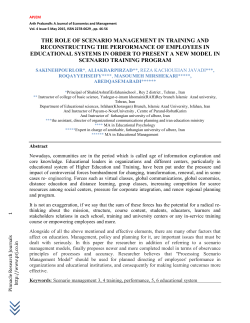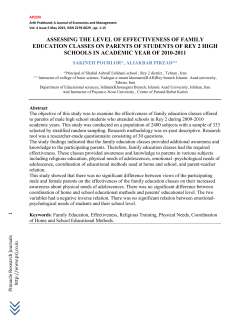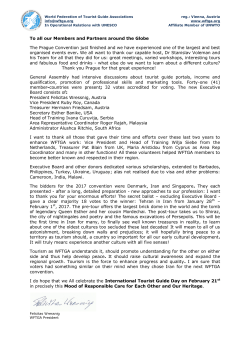
Journal of Women`s Health, Issues & Care
Fadaei A et al., J Womens Health, Issues Care 2015, 4:2 http://dx.doi.org/10.4172/2325-9795.1000182 Journal of Women’s Health, Issues & Care Research Article A SCITECHNOL JOURNAL Knowledge, Attitude, and Practice about Emergency Contraception among Women in Shahriar, Tehran, Iran Akram Fadaei1, Ladan Haghighi2 and Marzieh Nojomi3* 1Master of Family Medicine, Health affairs of Iran University of Medical Sciences, Tehran, Iran 2Department of Obstetrics and Gynecology, Iran University of Medical Sciences, Tehran, Iran 3Professor of Community Medicine, Department of Community Medicine, School of Medicine, Preventive Medicine Research Center, Iran University of Medical Sciences, Tehran, Iran *Corresponding author: Marzieh Nojomi, Department of Community Medicine, School of Medicine, Iran University of Medical Sciences, Crossroads of Hemmat and Chamran Expressways 15875-6171, Tehran, Iran, Tel : +98 21 88602225; Fax : +98 21 88602217; Email: mnojomi@iums.ac.ir Rec date: Jul 11, 2014, Acc date: Mar 03, 2015, Pub date: Mar 07, 2015 Abstract Objective: The objective of current study is to determine the knowledge, attitude, and practice of women who attended to health care services regarding methods of emergency contraceptive (EC) in Shahriar, Tehran, Iran. Methods: Using a cross-sectional design over a period of three months in 2013, data was collected. We used a convenience method of sampling and married women of aged 15-49 years old who attended to health care services in Shahriar were enrolled. A self-administered and reliable (Cronbach’s alpha=0.87) questionnaire with likert rating scale was used to collect data. Results: A total of 300 married women were enrolled in final analysis. The mean age was 28.5 (± 6.7) years. Majority of women were less than 34 years old (83%). Sixty percent of women have ever heard about EC. Of the total, 18% of women believed that using EC is illegal. Women who had ever taken EC had a better knowledge about these methods. Education of women was associated with knowledge about EC. Women who had used EC at least once was younger than women who had never used these methods significantly (27.5 ± 6 versus 29.2 ± 7) (P=0.04). Conclusion: This study showed that knowledge and attitude of studied women as a lay person about EC is almost fine and acceptable respectively. The knowledge about various methods of EC and golden time of using them was not satisfy. Attitude about EC was acceptable especially for safety of these methods. About one third of women reported ever use of these methods. Introduction Unwanted pregnancy is an important issue in reproductive health especially among young women in developing countries. Unintended pregnancy could lead to unsafe abortion that is one of the most important causes of maternal morbidity and mortality. Prevalence of unwanted pregnancy in women who had attended to a general teaching hospital in Tehran was estimated about 27% [1]. Almost 19% of these women had a history of abortion [1]. In a population based study in Tehran, the rate of abortion was reported 46%, in which, about 21% was induced [2]. The history of abortion was more prevalent in women aged 15 to 24 years versus older women [2]. Although total fertility rate in Iran is estimated 1.87 in 2012 [3], but our country has a young population with 45% under 24 years old [4]. Therefore, control of unwanted pregnancy and abortion is an important health issue for our policy makers. Beside the health effects of unwanted pregnancy and abortion, and the economic implication of this problem could be considered too. Emergency contraception (EC) is a method to prevent pregnancy after unprotected sex. This method could be used after a sex in which contraception method did not work or women have used them in a wrong way. Sometimes, this method recommended when no contraceptive was used at all. Emergency contraception is effective just in the first few days after coitus before the ovum is released from the ovary and before the sperm fertilizes the ovum. There are two methods of emergency contraception: emergency contraceptive pills (ECPs) and copper-bearing intrauterine devices (IUDs). When inserted within five days of unprotected intercourse, a copper-bearing IUD is the most effective form of emergency contraception available. The emergency contraceptive pill regimen suggested by World Health Organization is one dose of levonorgestrel 1.5 mg, taken within five days (120 hours) of unprotected coitus [5]. Levonorgestrel and Ethinyl Estradiol Tablets Low dose (LD), High dose (HD), and Levonorgestrel (just progestogen pill) are using as contraceptive pills in health care services in Iran. It has been shown about 54% of unwanted pregnancy was occurred in women who had used a method in a wrong way [1]. Using IUD and contraceptive pills 72 hours after sexual intercourse could prevent unwanted pregnancy 99% and 75-85% respectively [6-8]. The rate of unwanted pregnancy could be a criteria for not having adequate knowledge about using contraception methods especially emergency contraceptives. Using these methods as a second chance to prevent pregnancy after sexual contact needs knowledge and positive attitudes about them. A study was conducted in Shahrekord of Iran, showed just 22% of women have adequate knowledge about these methods [9]. There are three other studies about knowledge of using EC in Iran in which medical science students [10], pharmacists [11] and care providers in public health centers [12] were evaluated. We could not find more studies about knowledge of using EC on lay person but Shahrekord survey in Iran [9]. Therefore, the aim of current study is to evaluate the knowledge, attitude, and practice of women who attended to health care services in Shahriar, Tehran, Iran. Keywords: Emergency contraception; Knowledge; Behavior; Women; Health services All articles published in Journal of Women’s Health, Issues & Care are the property of SciTechnol and is protected by copyright laws. Copyright © 2015, SciTechnol, All Rights Reserved. Citation: Fadaei A, Haghighi L, Nojomi M (2015) Knowledge, Attitude, and Practice about Emergency Contraception among Women in Shahriar, Tehran, Iran. J Womens Health, Issues Care 4:2. doi:http://dx.doi.org/10.4172/2325-9795.1000182 Material and Methods Subjects and design Shahriar is a city located in West of Tehran with 328,191 population. The residents of Shahriar are categorized as almost medium/low income people. The literacy of majority of people is high school graduated. This city has a large growth rate majority due to immigration. Using a cross-sectional design over a period of three months from August to November 2013 data was collected. We used a convenience method of sampling to select eligible women for the study. Married women aged 15-49 years old who attended to health care services in Shahriar were enrolled. Women who had not enough literacy to fill-out questionnaire was excluded (less than 5%). Therefore convenience sample of 325 subjects were studied. The device of collecting data was a structured questionnaire. Women were asked when they were waiting for any visit in health care services. All women signed informed consent to participate in the survey. This study was approved by institutional review board of medical school of Iran University of Medical Sciences. respectively. To compare mean across two groups of demographic variables independent sample t-test was used. Chi-square test was used to compare categorical variables. Pearson correlation analysis was used to assess relationship between numerical variables. Data analysis was performed by SPSS version of 20.0 (SPSS Inc., Chicago, Ill., USA). Significance was set at 0.05 for all analyses. Results Descriptive findings Of the total attended women during study period, 60% (325 subjects) said that they ever heard about EC. This sample was enrolled to the study. Out of 325 questionnaires, 300 completed questionnaires were returned. Finally, 300 married women aged 15-49 years old were analyzed (response rate of 92%). The demographic and some reproductive variables of the respondents are shown in Table 1. Characteristics Number percent Age (n=300) Measures and device 15-24 94 31.3 A self-administered questionnaire that was used in a national wide survey conducted by Ethiopian Family Guidance Association (FGAE) in 2002 [7] was applied to the subjects in current survey. We made some modifications to the items to make them customize for using in our subjects. 25-34 155 51.7 35-49 51 17.0 Preliminary 61 21.0 Secondary & High school 92 31.7 High school graduated 122 42.0 Academic 15 5.0 Less than 2000,000 27 9.0 2000,000 – 6000,000 223 76.3 More than 6000,000 42 14.3 Preliminary 99 33.3 Secondary & High school 102 34.2 The questionnaire was tested in a small sample of women (n=30) as a pilot stage to test clarity and reliability of items. The Cronbach’s alpha for knowledge and attitude domains were 0.87 and 0.82 respectively. High school graduated 88 29.5 Academic 9 3.0 Statistical methods None 46 15.3 Internal consistency reliability of dimensions of the questionnaire was assessed using the Cronbach's alpha coefficient. Alpha values equal to or greater than 0.70 were considered satisfactory. Frequency tables and central tendency index (mean and standard deviation) were used to describe categorical and numeric variables respectively. In order to compare knowledge based on explanatory variables, we scored items of knowledge as two score for correct answers and one score for wrong answers. Then we calculated mean as average of knowledge. Maximum and minimum scores were two and one One or two 199 66.5 Three and more 50 16.7 Yes 152 52.2 No 139 47.7 The questionnaire in current study had five sections. The first two parts were assessed demographic and obstetric characteristics of women. Age, education, income and education of spouses of women were collected as demographic variables. Obstetric/gynecologic history was evaluated using five items included: number of children, ever using of contraceptives method, history of unwanted pregnancy, ever using of EC, and the source of taking knowing about EC. The staff of health centers asked about the “ever heard of EC” at the first of recruiting the women. If they answered “no”, they were excluded. The third to five sections of questionnaire were evaluated knowledge, attitude, and practice of women about EC respectively. Knowledge about EC was evaluated through fourteen questions with “yes” and “no” answers. Using ten and three questions attitude and practice of women about EC were assessed respectively. A likert scale with three points ranged from “agree/no idea/ to disagree” was used to assess attitude. Volume 4 • Issue 2 • 1000182 Literacy (n=290) Income (Rials, Iranian Currency) (n=292) Education of spouse (n=298) Number of children (n=299) Ever use of contraception (n=291) Unwanted pregnancy (n=297) • Page 2 of 5 • Citation: Fadaei A, Haghighi L, Nojomi M (2015) Knowledge, Attitude, and Practice about Emergency Contraception among Women in Shahriar, Tehran, Iran. J Womens Health, Issues Care 4:2. doi:http://dx.doi.org/10.4172/2325-9795.1000182 Table 2 illustrates the responses to items regarding knowledge about EC. Majority of women (more than 70%) did not know EC could be used till six and seven days after unprotected coitus. About two third of respondents did not know that contraceptive pills could be used as EC. This rate about using IUD as an emergency contraceptive was 64%. Mean and standard deviation for knowledge were 1.38 and 0.23 respectively. Yes 66 22.2 No 231 77.7 Health care services 237 79.0 Media 27 9.0 Attitude of participated women about EC was shown in Table 3. Other (friends, relatives,..) 36 12 Item Num ber Perc ent Using this method is illegal 54 18.2 This method can produce problems for reproduction in future 61 20.7 Men can force women to use this method if they know about that 54 18.2 Using this method could prevent from unwanted pregnancy 129 43.3 This method could be useful for abortion 27 9.3 Using this method maybe dangerous for women in future 83 28.2 If I know this method is safe, I’ll use it in future 122 41.4 Using this method just by physician’s prescription is possible 132 44.4 This method should not be used without consultant with physician 140 47.3 This method is not accessible for public use 116 39.1 Source of taking information about emergency contraception (n=300) Table 1: Socio-demographic and reproductive characteristics of women in Shahria The mean age was 28.5 (± 6.7) years. Majority of women were less than 34 years old (83%). Academic degree was just for 5% of respondents, and about 85% had less than 6000000 Rials (Iranian currency) per month. About 17% of women had three or more children, and 52% had a history of taking contraceptives. The rate of unwanted pregnancy was 22.2%. Health care services were the main source of taking information (79%) about EC for respondents. Item Yes No Is it possible using EC after rape? 118 (40.5) 173 (59.5) Is it possible using this method after rupture of condom? 160 (58.1) 125 (43.9) Is it possible using this method after forgetting to take pills? 135 (47.0) 142 (53.0) Is it possible using EC instead of an ordinary contraception sometimes? 123 (44.2) 155 (55.8) Is it possible using this method immediately after coitus? 136 (47.1) 153 (52.9) Is it possible using this method until 6 days after unprotected coitus? 94 (32.9) 192 (67.1) Are some methods of EC useful until seven days after coitus? 40 (13.3) 240 (80.0) Could this method prevent unwanted pregnancy up to 90%? 168 (58.9) 117 (41.1) Is it possible using low dose pills as a method of EC? 87 (33.6) 172 (66.4) Is it possible using high dose pills as a method of EC? 129 (45.3) 155 (54.4) Regarding evaluation of women’s practice about EC, 33% reported ever using of EC as a method of contraception. About 39% of these women said that health care staff offered this method as an EC to them. This proportion for offering from their spouse was 31%. The reasons of using EC for more than one third of women, who had a history of using them, were rupture of condom and forgetting to take oral contraceptives. Is it possible using Levonorgestrel (just progestogen pill) as an EC? 135 (46.9) 152 (52.8) Analytic findings Is it possible using triphasic pills as an EC? 105 (38.0) 171 (62.0) Knowledge Is it possible using IUD† as an EC? 102 (35.8) 183 (64.2) Women who had ever taken EC had a better knowledge about these methods versus women without history of using EC significantly (1.50 ± 0.19 versus 1.32 ± 0.22) (P=0.0001) *The correct answer for all items is “yes” †Intra uterine devices Table 2: Knowledge about emergency contraception (EC) among women in Shahriar. Volume 4 • Issue 2 • 1000182 Table 3: Percentage of answers of “agree” to items of assessing attitude about emergency contraception among women in Shahriar. Of the total, 18% of women believed that using EC is illegal. Just 9% of women believed this method could be used as a method for abortion. About one third of women believed this method could be a risk for health of them in future. Ordering of EC method just by physicians (is not an over-the-counter drug) was belief of 44% of women. Of the total, 39% believed that EC methods are not accessible for public. Women with positive history of unwanted pregnancy had a higher score for knowledge about EC compared to women who had not a history of unwanted pregnancy significantly (1.45 ± 0.23 versus 1.36 ± 0.23) (P=0.01). Education of women was associated with knowledge about EC. Women with education more than preliminary had a better • Page 3 of 5 • Citation: Fadaei A, Haghighi L, Nojomi M (2015) Knowledge, Attitude, and Practice about Emergency Contraception among Women in Shahriar, Tehran, Iran. J Womens Health, Issues Care 4:2. doi:http://dx.doi.org/10.4172/2325-9795.1000182 knowledge about EC versus women with preliminary education (1.42 ± 0.24 versus 1.30 ± 0.22). This difference was significant (P=0.003). There was an almost weak and significant correlation between age of women and knowledge about EC (r=-0.15, P=0.01). Younger women had a better knowledge. There was not any significant correlation between knowledge about EC and number of children. There was not any significant association between knowledge about EC with income and education of women’s spouses. Practice Women who used EC at least once was younger significantly than women who never used these methods (27.5 ± 6 versus 29.2 ± 7) (P=0.04). Number of children of women who had used these methods was less than women who had not taken EC (1.4 ± 0.98 versus 1.6 ± 1.2). This difference was not significant. There was an association between education of women and using EC. Proportion of high school graduated was 42.4% and 29.3% in women who had taken and had not taken EC respectively (P=0.0.3). Women who had used at least once EC had more monthly income compared to women who had not taken these methods significantly (P=0.01). Sixty four percent of former group versus 48% of later group had more than 4000,000 Rials monthly. Discussion The objective of current study was to determine knowledge, believes and practice of women regarding EC in Shahriar, Tehran. These methods have an important role on unwanted pregnancy leading to unsafe abortion as a main cause of maternal morbidity and mortality. We showed 60% of women had heard about EC. About half of women believed this method could be used to prevent unwanted pregnancy. Younger women ever used more EC than older ones. A study in Trinidad, Spain, has reported 63% awareness about EC among university students [13]. This proportion in another study on female university students in Ethiopia was 43.5% [14]. The awareness about EC were reported more than 90% in United States of America, and in United Kingdom [15,16]. It shows awareness about EC among women in current study was almost high. Because, studied women in current study were lay person with average literacy. But, majority of mentioned studies were conducted on university or college students. Out of women who had heard about EC, the main source of information was health care services (79%). Media, friends, and relatives were reported as the source of information just for 21% of respondents. In other similar studies, the most important reported sources were media, and friends [13,14]. This finding shows health care services and their staffs (primary care physicians, nurses, and other para-medical staffs) have an important role on awareness of women in our setting. This finding has an important message, that is, knowledge gained from a reliable source. It has been shown knowledge gained from friends or family is often unreliable and misleading [17]. We showed the general level of knowledge about EC is satisfied. Responses to majority of items (but one) assessing knowledge about EC was almost correct for half of women. Because the studied women were selected from a low educated population, this finding is acceptable. For one item in which effectiveness of EC till seven days after unprotected coitus was asked, the response was correct just for 13% of women. It is an expected finding, because it is a long time after unprotected coitus, and majority of people think this method could not act on pregnancy till seven days. Volume 4 • Issue 2 • 1000182 The attitude of women towards EC was almost acceptable overall. Almost 21% of women believed that the using EC could produce reproductive problems for them. This low percent shows a positive attitude about using EC and tell us majority of studied women believed these methods are safe. Safety of methods of pregnancy contraception is an important factor to promote using them. In study on students in Trinidad about 76% of subjects thought that EC are harmful for the body, and 31% believed that EC may effect on pregnancy in the future [13]. Forty four percent of the women believed that EC could prevent unwanted pregnancy. This is an important finding because could show these women knew about using these methods in case of unprotected coitus. Almost 9% of women thought these methods are not useful for abortion. This finding could be addressed as a positive attitude because actually using EC is not acceptable for abortion and using them has time limitation. About 44% of women believed these methods are not available without prescription. In study of Parey et al. about 60% of subjects knew these methods are available without prescription [13]. This finding in current study shows women need more knowledge about accessibility of these methods. Strength points of current study included, studying on lay person about EC, and addressing knowledge, attitude, and practice of women about using EC together. We could not find similar study in our setting. One of the limitations of current study was almost small sample size, studying on a specific group of women versus population based. Using such a convenient sample could limit the generalizability of findings. In conclusion, our study showed that knowledge of studied women about EC is almost satisfy. The knowledge about various methods of EC and period time of using them were not fine. Attitude about EC was acceptable overall, specially for safety of these methods. About one third of women were reported ever used of these methods. Ever using of EC was associated with age and education of women. Younger and educated ones used these methods more than versus groups. Education of women also had a positive association with knowledge about EC. Acknowledgements This study was approved and funded by Iran University of Medical Sciences. References 1. 2. 3. 4. 5. 6. Nojomi M, Zeinali Z (2005) Study of unwanted pregnancy prevalence and related factors in women referred to prenatal clinics of Akbar-Abadi and Rasoul-e-Akram hospitals in 2002. Iran University of Medical Sciences Journal 12: 195-200. Nojomi M, Akbarian A, Ashory-Moghadam S (2006) Burden of abortion: induced and spontaneous. Arch Iran Med 9: 39-45. www.indexmundi.com/iran/total_fertility_rate.html www.indexmundi.com/iran/demographics_profile.html www.who.int/mediacentre/factsheets/fs244/en/ www.cecinfo.org/custom-content/uploads/2014/01/ ICEC_Medical-and-Service-Delivery-GuidelinesEnglish_June-2013.pdf • Page 4 of 5 • Citation: Fadaei A, Haghighi L, Nojomi M (2015) Knowledge, Attitude, and Practice about Emergency Contraception among Women in Shahriar, Tehran, Iran. J Womens Health, Issues Care 4:2. doi:http://dx.doi.org/10.4172/2325-9795.1000182 7. 8. 9. 10. 11. 12. FGAE (2002) Base line survey of the coital dependent methods project of the Family Guidance Association of Ethiopia and Population Council. Friedman S, McQuaid, Grendell J (2003) Current Obstetrics & Gynecology Diagnosis & Treatment. (9th edn), McGraw-Hill Companies. Delaram M (2008) Knowledge and perception of emergency contraception of women in Shahrekord-Iran. J Fam Reprod Health 2: 143-146. Delaram M, Rafie H (2012) Knowledge and attitudes of emergency contraception among medical science students. Future of Medical Education Journal 2: 9-13. Mostafavi SA, Sabzghabaee AM, Mirmoghtadaee P, HoseiniBiuki SM (2011) Emergency contraception and the knowledge of community pharmacists in isfahan, iran. Int J Prev Med 2: 252-255. Mohammad-Alizadeh-Charandabi S, Farshbaf-Khalili A, Moeinpoor R (2011) Emergency Contraception: Providers’ Knowledge and Attitudes and Their Relationship with Users’ Knowledge and Attitudes at Public Health Centers/Posts of Tabriz. J Caring Sci 6: 48-54. Volume 4 • Issue 2 • 1000182 13. 14. 15. 16. 17. Parey B, Addison L, Mark JK, Maurice B, Tripathi V, et al. (2010) Knowledge, attitude and practice of emergency contraceptive pills among tertiary level students in Trinidad: A cross-sectional survey. West Indian Med J 59: 650-655. Tamire W, Enqueselassie F (2007) Knowledge, attitude, and practice on emergency contraceptives among female university students in Addis Ababa, Ethiopia. Ethiop J Health Dev 21: 111-116. Vahratian A, Patel DA, Wolff K, Xu X (2008) College students' perceptions of emergency contraception provision. J Womens Health (Larchmt) 17: 103-111. Graham A, Green L, Glasier AF (1996) Teenagers' knowledge of emergency contraception: questionnaire survey in south east Scotland. BMJ 312: 1567-1569. Kongnyuy EJ, Ngassa P, Fomulu N, Wiysonge CS, Kouam L, et al. (2007) A survey of knowledge, attitudes and practice of emergency contraception among university students in Cameroon. BMC Emerg Med 7: 7. • Page 5 of 5 •
© Copyright 2025









